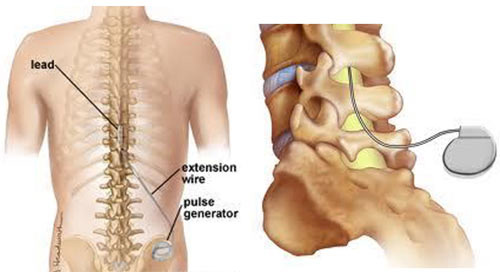 Midtown Manhattan
36 W 44th St Ste 1416 New York, NY 10036
Midtown Manhattan
36 W 44th St Ste 1416 New York, NY 10036
- (212) 621-7746
- text us
- BOOK ONLINE Call for Same Day Appointments
 Midtown Manhattan
36 W 44th St Ste 1416 New York, NY 10036
Midtown Manhattan
36 W 44th St Ste 1416 New York, NY 10036
To address chronic back pain, ask your doctor about spinal cord stimulation therapy. Although it’s not for everyone, it’s a minimally invasive procedure that can supply long-term pain relief. Spinal cord stimulation from a sports and pain specialist in NYC works through an implanted device that overrides the pain signals. Like a pacemaker, a spinal cord stimulator works continuously with minimal inconvenience. Come to our pain relief clinic to get your back pain evaluation and treatment. Meet our pain doctor Febin Melepura M.D. the experienced sports injury doctor.
 Living with chronic back pain brings with it many other physical and psychological side effects. When you’re in constant pain, even if it’s just a dull ache, it affects how you approach your day, how much you can participate in daily activities, and how you feel about yourself. If you’re experiencing chronic back pain, see your sports and pain doctor in Midtown Manhattan for effective pain relief.
Living with chronic back pain brings with it many other physical and psychological side effects. When you’re in constant pain, even if it’s just a dull ache, it affects how you approach your day, how much you can participate in daily activities, and how you feel about yourself. If you’re experiencing chronic back pain, see your sports and pain doctor in Midtown Manhattan for effective pain relief.
Usually, your physician starts with conservative treatments – such as over-the-counter medicine, physical therapy, or a nerve block injection – to resolve your pain. But if it continues and your doctor determines the cause is nerve damage, you may be a candidate for spinal cord stimulation therapy. While far from a radical procedure, spinal cord stimulation does require several minimally invasive surgeries, including one to place a trail device.
Nerve damage from previous back surgery is a rare side effect, but it can happen. Failed back surgery syndrome doesn’t mean your back surgeon failed, as there are many reasons why you still feel pain after your surgery. Other reasons to consider spinal cord stimulation include:
If any of these situations apply to you, you may benefit from a spinal cord stimulator. This procedure doesn’t cure your condition, but it does mask the pain so you can live your life pain-free. Deciding to have the procedure isn’t a rash decision, but one that you reach after a clear conversation with your doctor.
I had a spinal cord stimulator inserted before I saw Dr. Melepura, but I stopped using it because I kept being shocked when I turned it on. My experience with Dr. Melepura has been wonderful. The best thing I could have done to manage my discomfort was to have him switch the manufacturer of my stimulator. Now that I take fewer pills, my life is a lot easier!
Helen CraigSpinal cord stimulation therapy involves implanting a wire underneath your skin next to your spinal column, at the point of your pain. After a successful test to make sure the device works for you, you can receive the permanent device, which your doctor places under your skin just above your buttocks. The battery-operated device sends electrical impulses to your spine, which hides the pain signals.
The process of placing the wire leads and the device requires several minor surgeries. All are outpatient procedures that are done in our sports pain management clinic in Manhattan. The process involves a number of steps. After determining that you may be a good candidate for spinal cord stimulation therapy, your doctor has to make sure the technique works for you:
If the test device reduced your pain to tolerable levels — the goal is often between 50 and 70 percent reduction — you can receive the permanent spinal cord stimulation device:
While the procedure itself is painless, for the most part, carrying the device can be a bit uncomfortable at first. But if it works, you’ll consider the inconvenience worthwhile. The device is removable in a separate surgery, but you may not desire that if it’s working as well as the test device.
Do you have any questions about spinal cord stimulation therapy? Would you like to schedule an appointment with the best-rated pain doctor Febin Melepura MD of a sports pain management clinic in New York? Please contact our office for a consultation with the pain relief specialist in Midtown Manhattan.
Sports Injury & Pain Management Clinic of New York
Febin Melepura, MD is a top rated, best in class interventional pain management doctor. He is a nationally recognized pain relief specialist and is among the top pain care doctors in New York City and the country. He is an award winning expert and contributor to a prominent media outlets.
Dr. Febin Melepura has been recognized for his thoughtful, thorough, modern approach to treating chronic pain and, among other accolades, has been named a “top pain management doctor in New York”, and one of “America’s Top Doctors™” for an advanced sports injury treatments.